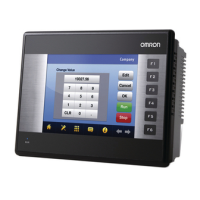CHAPTER 14 – Using CX-Supervisor as an OPC Client OMRON
Page 232 Release 2.0
In other words, DCOM is an object-programming model for the implementation of distributed
applications using a client server pattern. A client can use several servers at the same time and a
server can provide functionality to multiple clients simultaneously.
Translating that into plainer English, COM basically allows software components to be written in
such a way that they can be used by all COM-aware applications (e.g. C++, later versions of Visual
Basic) without those applications needing to know anything about the “internals” of the object.
DCOM is simply the distributed version of COM – i.e. the objects can be spread across a network. It
is a very powerful system, although some machine-level and security configuration may be required
to allow it to work correctly and reliably.
Central to the capability of a DCOM object are its interfaces. All communication with a DCOM
object occurs through its interfaces – an interface is said to provide a “contract” (a full and
unchanging description) for the functionality provided by that object. Each interface has a unique ID
and describes a group of related methods. The description of the interface defines the syntax and the
semantics of the services provided by that interface – the internal implementation of those services
doesn’t matter to the calling applications.
In the case of OPC these interfaces for each of the DCOM objects are defined within the relevant
specifications. This guide only deals with the OPC Data Access specification Custom (used by C++)
and Automation (used by script languages and VB) interfaces.
What are the benefits of OPC?
Asking what the business benefits of OPC are is like asking what the benefits of plug-and-play
technology are to the computer industry. More choices, better access to process data, ease of plug-
and-play operation, and efficient utilization of development resources are the main benefits of OPC
technology. OPC brings the value that comes with the use of standards, including reduced training
costs, reduced custom development costs, and lower long-term maintenance costs. By design, OPC-
compliant products work seamlessly with one another. With this plug-and-play approach, off-the-
shelf components can be brought together efficiently to solve immediate requirements. In addition,
long-term maintenance and upgrading can be achieved by removing and replacing individual
components in a system without any work needed to “wire up” the new pieces. To illustrate the
savings, imagine the increase in cost if every household appliance had its own type of wall plug.
Eliminating customisation drastically reduces the cost of an automation system by saving money
during acquisition, installation, and maintenance.

